If the thought of product documentation doesn’t exactly give you an adrenaline rush, don’t worry—you’re not alone.
Many SaaS companies treat product documentation as an afterthought.
They know they should have it because most other companies do, but they don’t put much thought into how to use all of its potential.
And that’s a shame, because the potential is significant.
In this article, you’ll learn what kinds of product documentation there are and what benefits they bring, as well as what to pay attention to when creating them.
Let’s start!
Types of Documentation SaaS Products Need
SaaS product documentation can come in many shapes and forms.
However, we can divide SaaS product documentation into two major categories based on their intended audience.
Let’s explore those categories in more detail.
User Manuals
Every SaaS company that wants its product or service to succeed should do its best to attract and retain customers.
And while writing great product documentation might not be the primary method of attracting them, it’s undoubtedly one of the most important factors in retaining them.
That’s why it’s crucial to have customer-facing documentation like user manuals—and not just have it for the sake of being able to say that you do, but to pack it with as much information about using the product or service as possible.
By educating customers about the features and uses of their service, SaaS companies can reduce customer churn.
According to data from Wyzowl, 80% of customers have abandoned a service because they didn’t know how to use it.
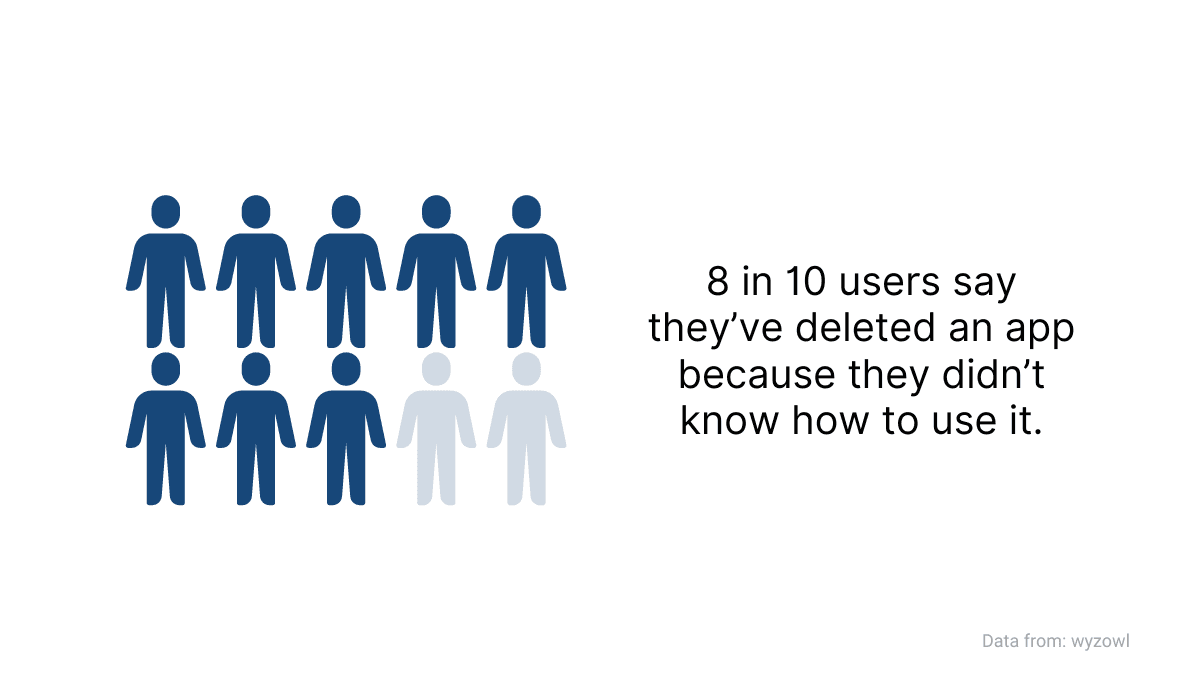
Source: Archbee
By creating detailed and user-friendly manuals, you can eliminate the possibility of customers leaving because of confusion or frustration with your service.
As Simon Lampern, founder of Vinsight Software, explains, great user manuals are more than enough for most situations.
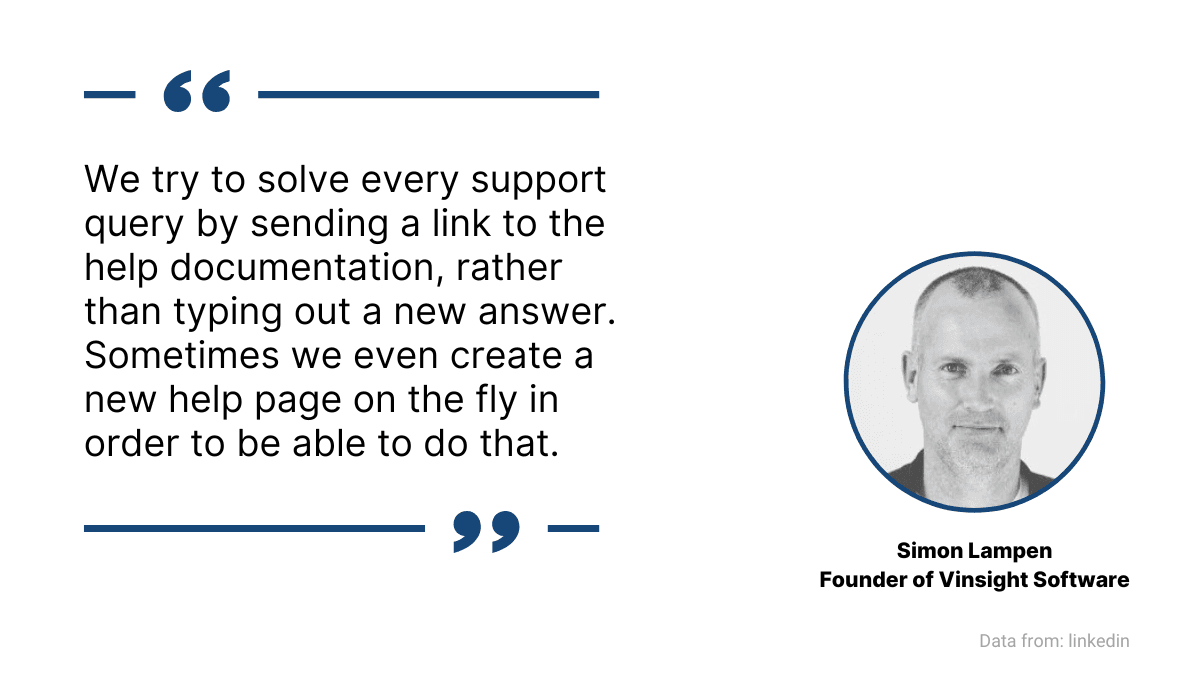
Source: Archbee
In essence, a great user manual can get a customer from a point where they know nothing about the product or service to a point where they can use it independently.
For instance, Trello, a popular project management tool, has a user manual created with that in mind.
As you can see below, it’s organized in steps, guiding the user from the basics of using Trello to advanced tips and tricks.

Source: Trello
It covers all the necessary information about the product, like creating boards, projects, automation, etc.
As you can see below, it also implements visuals for easier information transfer, making it even more user-oriented.

Source: Trello
A user manual like that can present all the features and advantages of a SaaS business while educating customers in the process.
Internal Documentation
Product documentation isn’t necessarily reserved only for your customers.
There’s a lot of information about the product that is vital for your employees, and that information comprises the other major category we mentioned earlier— internal documentation.
In short, internal documentation is compiling all of your company knowledge in one place. That way, every employee from every department can access it and get the information they need.
And considering how much time employees tend to spend looking for information, having comprehensive internal documentation should be among every SaaS company’s priorities.

Source: Archbee
So, what documents can be considered internal documentation?
Essentially, any records that help employees do their work and improve their knowledge of a product or a service:
- Product specifications
- Standard operating procedures
- Workflows
- Project documentation
- Internal infrastructure
- Architecture
- HR documentation
That list could be much longer, but the point is that internal documentation covers topics that are for the company’s eyes only, like this employee handbook from Slite’s internal documents.

Source: Slite
Furthermore, not only will your employees become increasingly more knowledgeable, but they’ll also be able to do their job better—software developers will be more productive, the marketing department will have a deeper understanding of the product in order to advertise it, customer support will be more efficient in solving issues, etc.
And all that thanks to the internal product documentation.
Why You Should Have Good Product Docs
Product documentation of high quality can bring many benefits to SaaS companies.
As we mentioned earlier, it can serve both customers and employees by providing detailed, relevant, and all-around helpful information about the company’s product or service.
But how exactly can that benefit your organization?
Let’s start with the first reason to create top-tier documentation—customer satisfaction.
More Satisfied Customers
If you put effort into your product documentation, one of the most valuable benefits will be the increased satisfaction of your customers.
But why would customers even care about your product documentation? After all, no one signs up for a service or buys a product because of how amazing the user manual is.
The reason is simple—as we mentioned earlier, customers don’t have infinite patience, and many are ready to go to a competitor if they encounter insurmountable problems.
Also, when they encounter an issue or have a question, most prefer to deal with it on their own—73% of them, according to a report by Aspect Software.
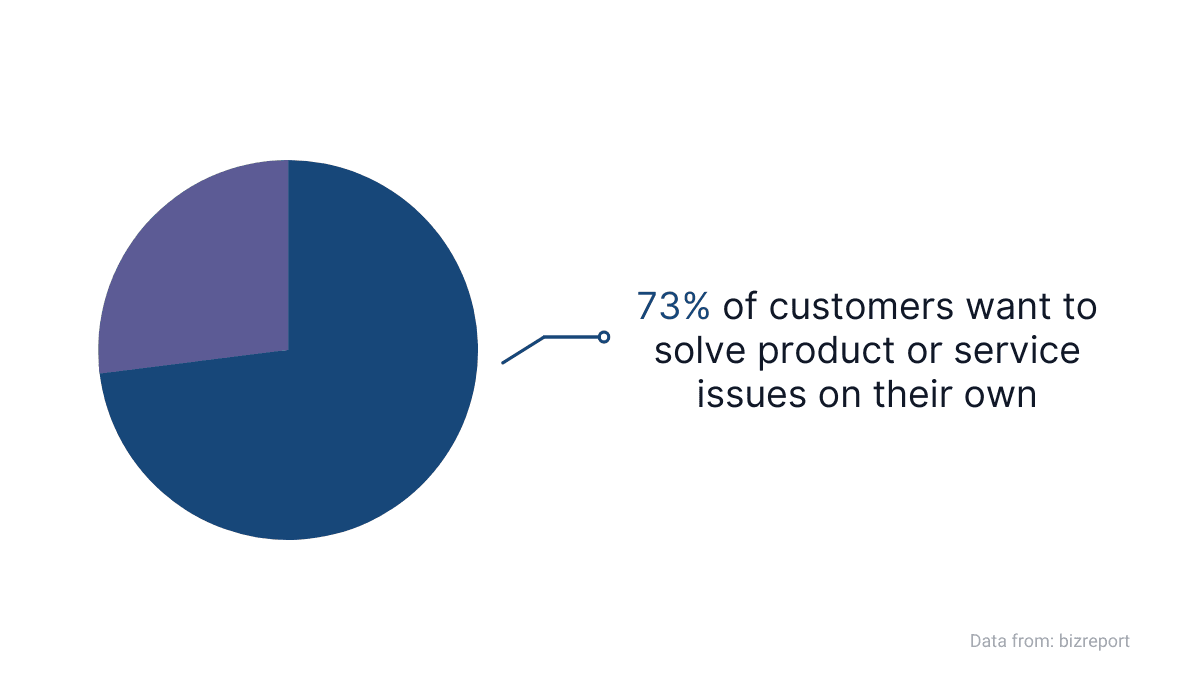
Source: Archbee
Therefore, creating great product documentation is an excellent way to ensure customer satisfaction.
That way, they have enough information to learn about the service or product by themselves, as well as deal with issues.
As Ed Shelley, Head of Revenue at Pitch, puts it, one great piece of product documentation can please an almost indefinite number of customers.
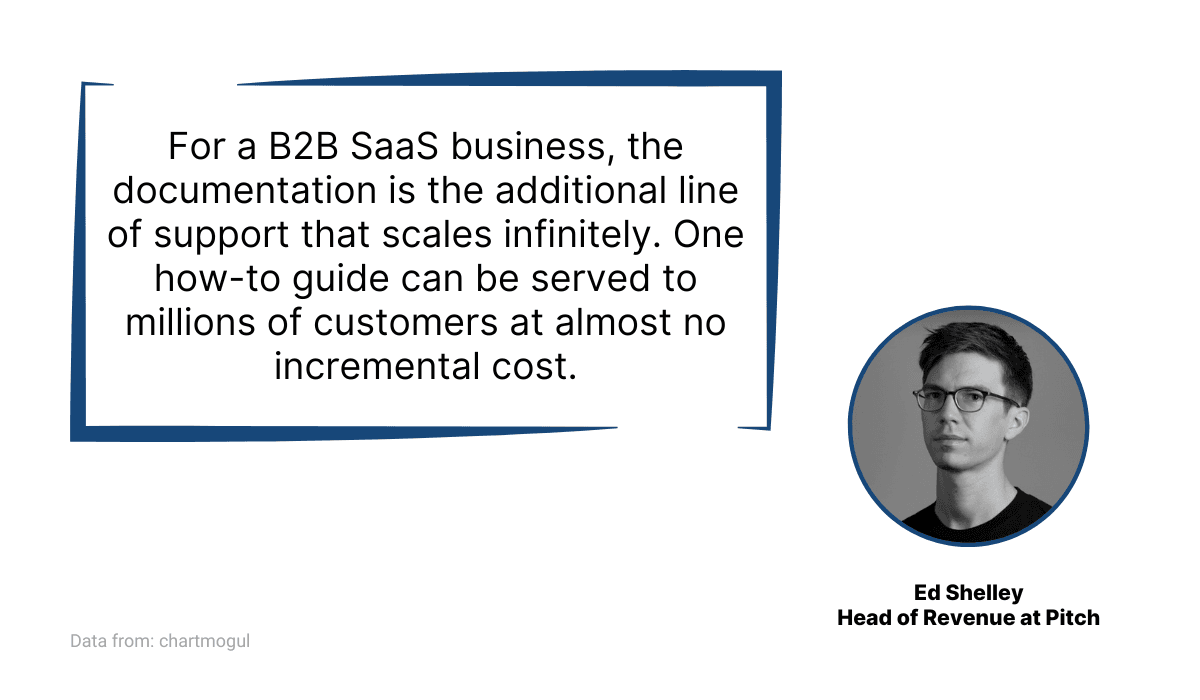
Source: Archbee
And when customers are satisfied, they are willing to share their satisfaction with the world.
That’s the case with product documentation too. For example, digital marketing influencer Ross Simmonds shared his thoughts about the Stripe product documentation on Twitter:

Source: Twitter
In other words, satisfied customers can translate into long-term repeat business and spread the word about the company.
If having top-notch product documentation can spark that, it’s well worth considering.
Easier Employee Onboarding
When a new employee joins the company, getting them up to speed with everyone else can be a big task.
They need to learn many things before they can start being productive—from the basics like setting up their equipment and tools to the company’s workflow and everything in between.
Not to mention adjusting to the new environment and coworkers. All in all, it’s safe to say that an onboarding process can make all the difference.
The data also supports that. According to research by Brandon Hall Group, companies with a good onboarding process increase the retention of new employees by 82%.

Source: Archbee
That’s certainly a significant number, and investing in your product documentation can help you achieve it.
How?
Well, if you have detailed product documentation for your employees in one place, like a company knowledge base, the new hires know where to turn when they have job-related questions.
Furthermore, that way, you can make things easier for your other employees, as they won’t have to dedicate a significant chunk of their time to training a new hire and showing them the ropes.
Comprehensive product documentation can step in for them.
That’s how Zapier approaches onboarding. They have all the documentation ready for new employees from day one.
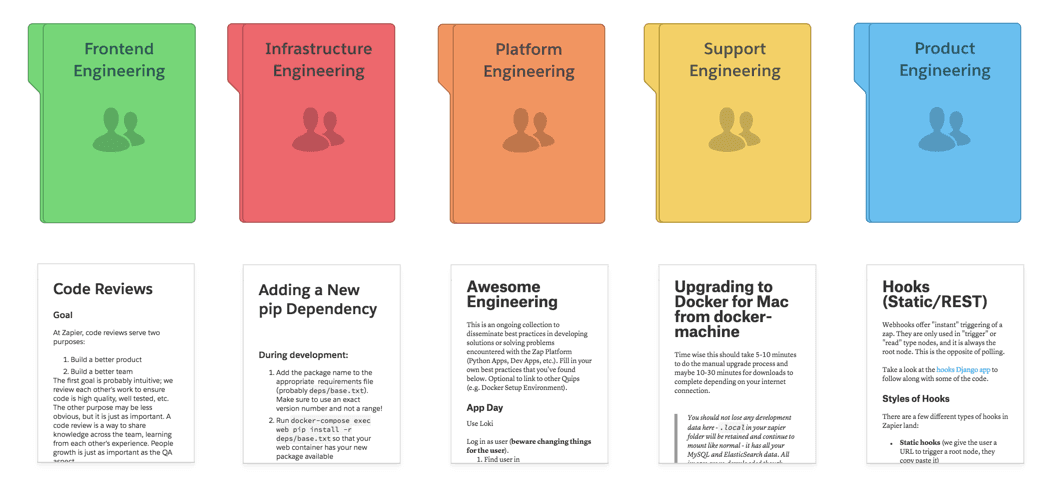
Source: Zapier
So, whether a new employee wants to know how to, for example, do a code review or deploy to production, they know exactly where to find answers.
That kind of attention to product documentation makes onboarding a smooth process for everyone involved—from the management to the newcomers.
Greater Internal Product Knowledge
The knowledge stored in the product documentation isn’t only valuable for new employees.
Even the most experienced workers need to check on some information from time to time, especially in SaaS companies—their products and services aren’t set in stone, and employees should be able to keep up with the changes.
Product documentation is excellent for that purpose. Keeping it up to date ensures that everyone in the company has access to vital product knowledge.
Also, access is often the key term here—product documentation should be easily accessible if you want to improve internal product knowledge.

Source: Archbee
As we mentioned earlier, internal product documentation can contain various sources useful for SaaS company employees.
For instance, below, you can see a product requirement document that provides information about system functionality.
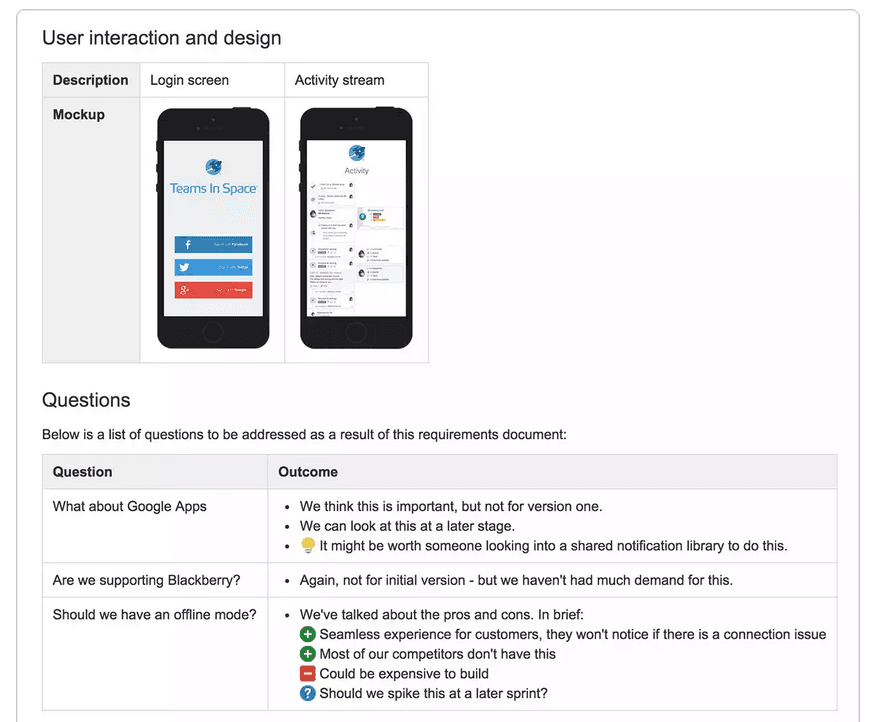
Source: altexsoft
That type of product documentation is crucial for software developers and engineers, as it contains the knowledge necessary to perform their tasks.
You can create and maintain internal product docs with any of the many tools available for that purpose.
However, Archbee, our own product, is one of the most comprehensive product documentation tools out there. Just look at the list of its features:
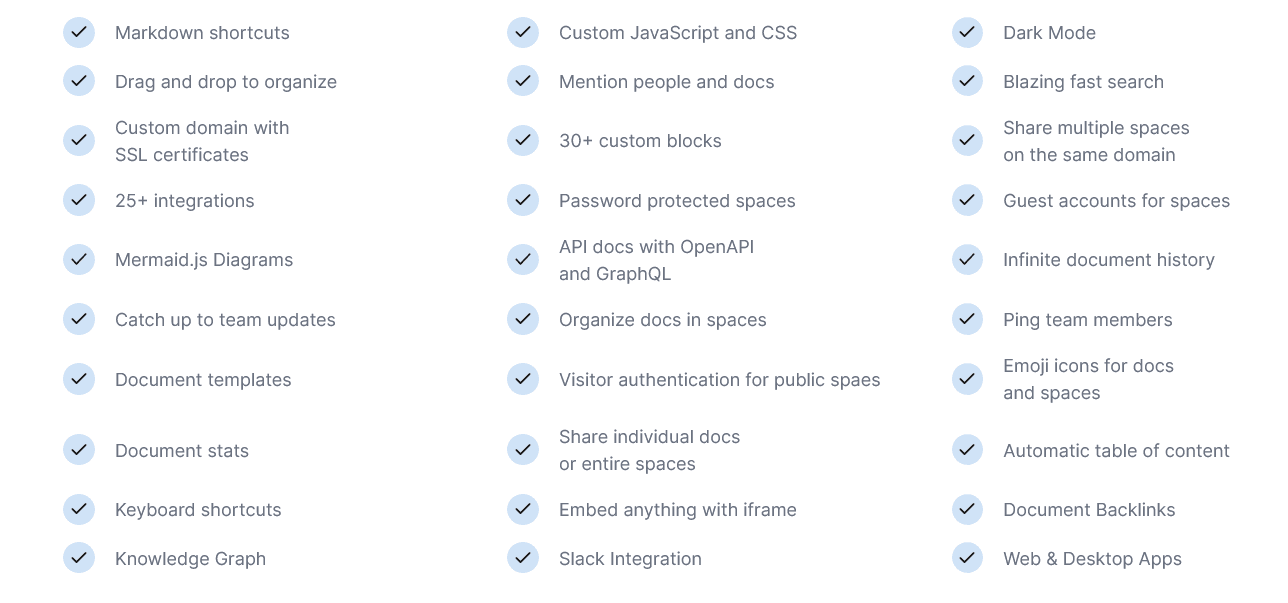
Source: Archbee
In short, you can fulfill all of your product documentation needs with Archbee—from writing and updating documents to collaborating with other team members and adjusting your internal documentation to your every need.
Having a repository for internal product knowledge like that is vital for improving your SaaS company because, as you already know, knowledge really is power.
What Should Good Product Documentation Have
Now that we have established what kind of SaaS product documentation you can have and why you should have it, let's get into its characteristics.
Good documentation should be complete, concise, contextual, and well-structured.
How can you achieve that? Let’s start with the first one.
Completeness
Imagine that you signed up for a service from a SaaS company, and you want to learn more about one of its features you’re particularly interested in.
You browse through their product documentation, and there’s no word about that feature.
Understandably, you’d be frustrated.
And no SaaS company wants frustrated customers.
Luckily, you can prevent that by creating detailed product documentation with everything a customer should know, as the technical writing blog Write the Docs advises.

Source: Archbee
Complete product documentation ensures that users at every level, from beginners to experts, have the information they need.
For instance, let’s look at Webflow, a SaaS company that provides software for building and hosting websites.
They have rich product documentation covering many useful topics:
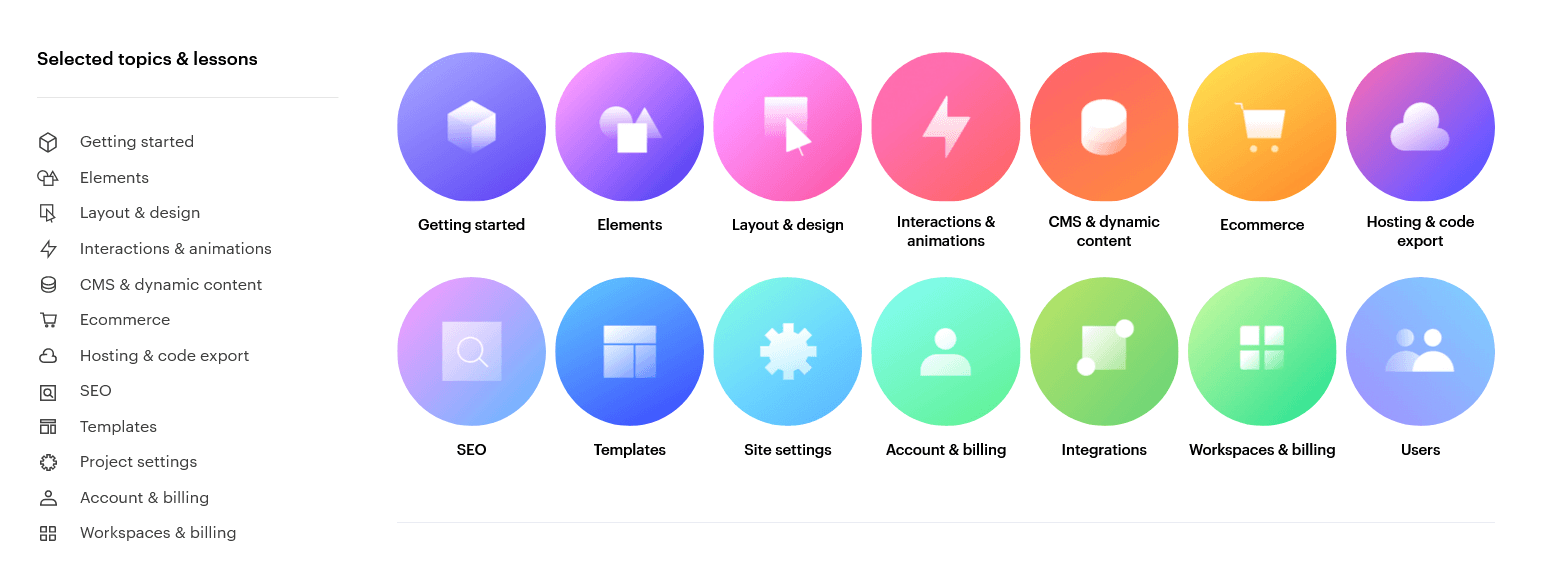
Source: university.webflow
As you can see above, they have 14 main categories covering basic features but also more advanced ones.
And that’s just the tip of the iceberg—if you open a list of all lessons, you get hundreds of articles.
For example, below are lessons in the Getting started category.

Source: university.webflow
We’ll spare you the counting—there are 26 of them.
Making an effort to create complete product documentation like that will make your users value your service or product even more.
This is a signal to them that you take care of your business, and value them as customers.
Conciseness
If a user reads your product documentation and gets lost in it by the end, you might have a problem.
Why? Because good product documentation should be concise and relevant.
Let’s get back to Write the Docs to see how they explain the conciseness of product documentation:

Source: Archbee
In other words, conciseness means getting the information across clearly and straightforwardly.
Keep in mind that users don’t read product documentation because they are looking for anecdotes or witty remarks—they want precise information without having to read pages of irrelevant text.
A great example of concise product documentation is the Dropbox Help Center.

Source: help.dropbox
As you can see, they feature only a few articles and tools at the top of the page. The rest of it is available when you scroll down.
Also, the writing is concise and relevant. For instance, an article about sharing a Dropbox file or folder starts with the most important information.
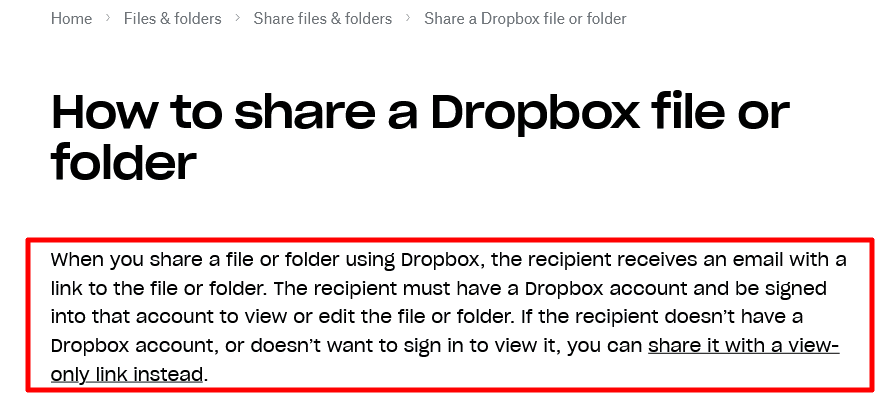
Source: help.dropbox
There are no unnecessary sentences—every line offers valuable information to the reader.
Only after that do they offer step-by-step instructions for sharing.

Source: help.dropbox
The steps are clear, concise, and relevant to the article’s topic.
Thanks to that, users can get to the information quickly, use it and solve their problems—precisely what they came for.
Contextuality
When the end users of your product documentation come to it, they usually want to find some piece of information quickly.
A car manual and internal documentation for developers are the same in that regard—readers open a document because they are in need.
Therefore, you should provide them context so they can immediately know if they will find the information they need in that document.
By doing that, you prevent any confusion and guesswork on their part.
For instance, below, you can see how Mozilla offers context to readers of the Firefox DevTools User Docs.

Source: firefox-source-docs.mozilla
They briefly explain what you can find in that section, so a user doesn’t have to read through it only to see that they’re on the wrong page.
That isn’t the only way to provide the context in your documentation.
For example, Stripe uses a method of contextual help called a tooltip. It’s a brief description that shows up when you hover your cursor over a particular part of the documentation.
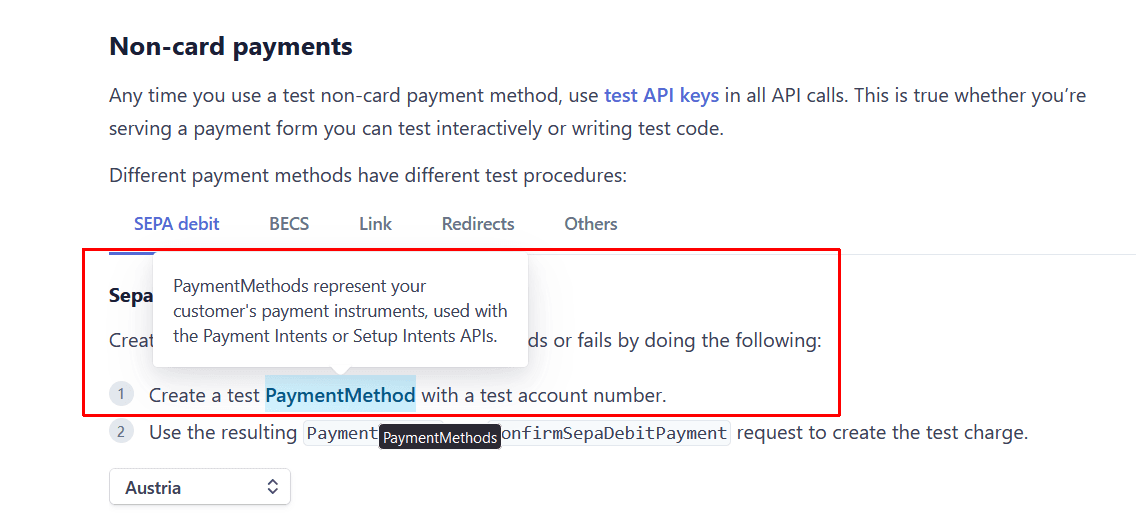
Source: Stripe
Above, you can see a tooltip that explains a PaymentMethod term, so that readers can understand it more easily.
To sum up, in documentation, providing context is one of the sure signs that the documents are of high quality. The writers created it with respect for their users’ time and point of view.
Structure
If you followed the advice for creating good product documentation, you packed it with information, made it concise and relevant, and provided context whenever possible.
But there is one more element that makes product documentation excellent—its structure.
The structure makes it easier for end users to find their way around your documentation, and the more detailed and rich it is, the more important the structure is.
Luckily, you make sure the structure is good by categorizing your documents logically and implementing ways to navigate the documentation.
For example, let’s look at the Airtable Help Center.
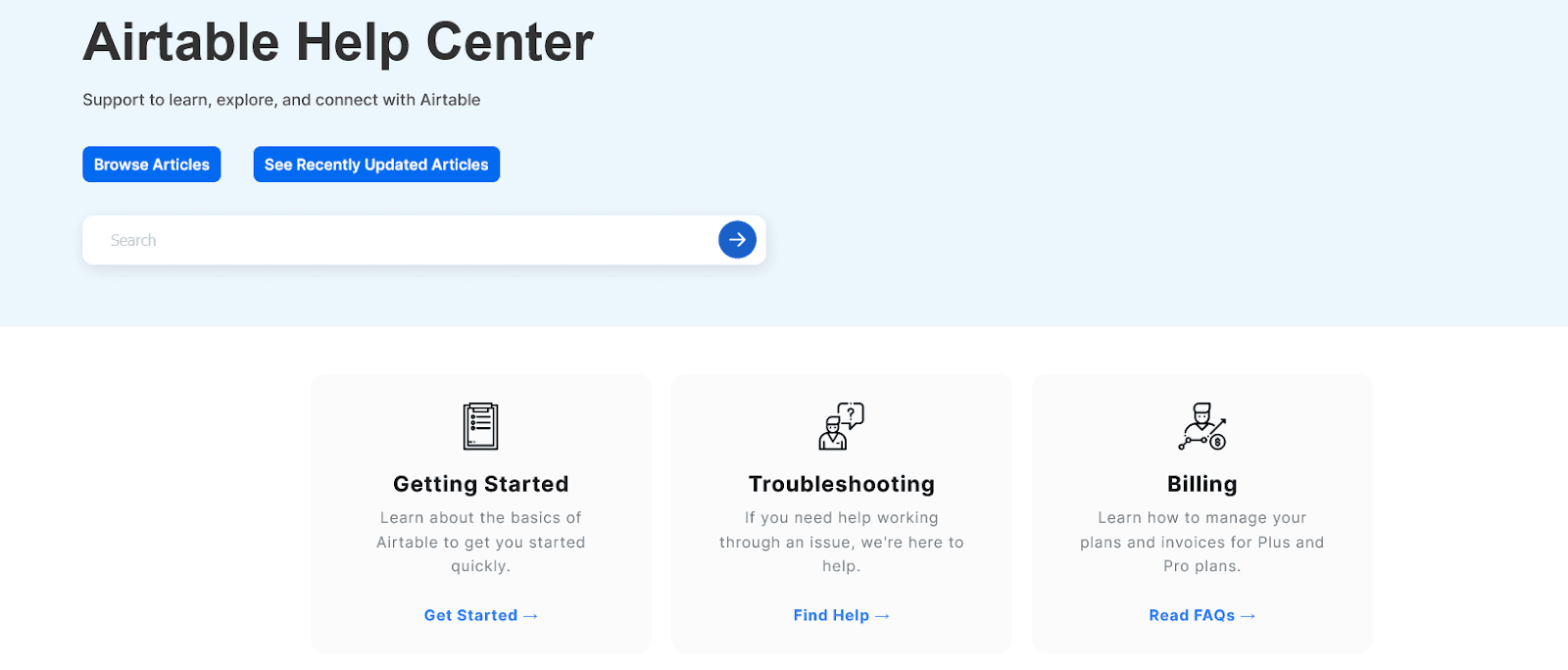
Source: support.airtable
As you can see, they divided their documentation into three main categories—Getting Started, Troubleshooting, and Billing.
That way, if the user has a general idea of what they need, they can open that category.
However, many more subcategories are underneath, so they can narrow down their search. Here are some of them:

Source: support.airtable
In addition to that, there are also articles divided by popularity and how recently they have been written or updated.

Source: support.airtable
Product documentation tools usually have features that help you create a logical and tidy structure.
For instance, Nexweave, a tool for creating personalized media, organized its product documentation in Archbee.
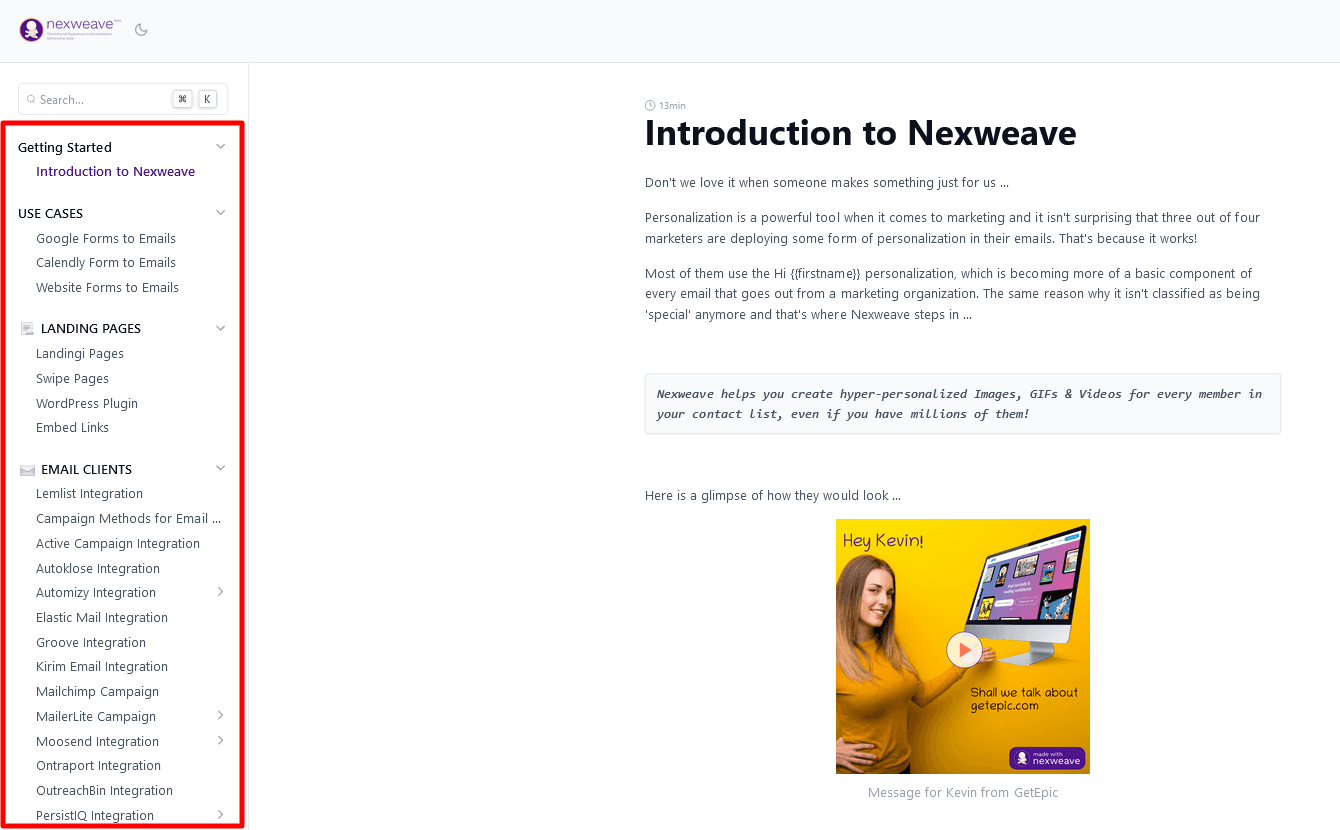
Source: documentation.nexweave
By dividing it into categories and subcategories, they have simplified the process of finding information for their users.
Conclusion
Regardless of the kind of product or service your company offers, quality product documentation can bring you many benefits.
If you create documentation with the goal of creating a comprehensive, straightforward, relevant, and structured source of information, you will soon see those benefits for yourself.
Why? Because product documentation with those qualities can serve as a customer support tool, internal knowledge base, marketing tool, and much more.
In short, it reflects the care and effort you put into your business. Don’t miss out on its potential.
Frequently Asked Questions
Most SaaS teams benefit from two core categories: customer‑facing docs and internal docs.
- Customer‑facing (user) documentation: Helps customers onboard, learn features, and self‑serve.
- Examples: getting started guides, how‑to articles, FAQs, troubleshooting, release notes, tutorials, video walkthroughs, in‑app tooltips.
- Internal documentation: Equips employees to build, support, and improve the product.
- Examples: product specs/PRDs, architecture diagrams, API references, runbooks, SOPs, workflows, project notes, onboarding checklists, infrastructure docs, HR policies.
Tip: If you’re early‑stage, start with a clear “Getting started” guide for customers and a few core SOPs/PRDs for the team. As you scale, deepen both libraries and keep them current.
- Customer‑facing (user) documentation: Helps customers onboard, learn features, and self‑serve.
